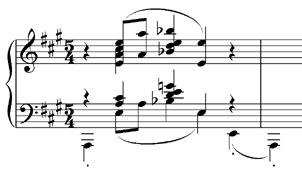Piano tuning fun has continued, albeit with a slight break for Midterm Mayhem!! Curiosity led me to getting out the library's copy of the greatest book ever (OCD sufferers are advised to stay away). Further curiosity led to some experimentation with the Thomas Young (well-) temperament of 1799. It didn't take long to realize how superior non-equal temperaments really are for playing tonal music. Keys really have distinct characters, intervals in general sound better, etc., etc., etc.
I'm wondering now about an issue in listening to tonal music: modulation. In all of my music history classes that covered tonal music, discussions of significant modulations always prompted someone to ask, "I can't hear this. Could people back in [whatever period] really pick up on it?" Each time, regardless of prof., the same answer: "Well, listeners then were much more attuned to these harmonic procedures."
Something about this answer always seemed...fishy. My current theory: it's hard to notice modulations within equal temperament because every key sounds the same. A temperament with distinct key characters makes it easy for listeners to notice modulations. When the quality of the tonic suddenly changes, you know you're in a different key. Do you even need relative pitch to figure that out? Consider the beginning of the Debussy prelude, "Les sons et les parfums tournent dans l'air du soir":
 When the piece modulates to Ab major, this melody, with identical harmonization, comes back. While the modulation is handled with the utmost smoothness, modulating by semitone definitely falls outside the bounds of common practice tonality. In the context of equal temperament, though, any modulation made with enough common tones sounds acceptable. Is it significant that Debussy chose a new key that neighbored the tonic on the chromatic scale instead of the circle of fifths? If you think of modulations as large-scale dissonances, then you get keys that clash by semitones instead of fifths.
When the piece modulates to Ab major, this melody, with identical harmonization, comes back. While the modulation is handled with the utmost smoothness, modulating by semitone definitely falls outside the bounds of common practice tonality. In the context of equal temperament, though, any modulation made with enough common tones sounds acceptable. Is it significant that Debussy chose a new key that neighbored the tonic on the chromatic scale instead of the circle of fifths? If you think of modulations as large-scale dissonances, then you get keys that clash by semitones instead of fifths.I'm guessing someone could pull out more links between equal temperament and Debussy's harmonic practices. Thinking more generally, what are other ways of "dealing" with working in equal temperament? You can...
- ...reshape functional harmony to work more effectively within the constraints of equal temperament (à la Debussy).
- ...build a harmonic system around the understanding that all 12 tones are equal (à la Schoenberg).
- ...downplay functional harmony, instead constructing music around rhythm/timbre/texture/etc. (take your pick).
2 comments:
I agree that the old "well-" temperaments were superior because of the characters that each key had (Davitt Moroney's Art of Fugue in K III is an amazingly good example of this), and there is probably also something to the idea that modulations for contemporary tonal diioms like jazz are more wide open due to equal temperament, but I don't think modulations are any more or less noticable today than they were 150+ years back. I'd have to see some hard data to convince me listeners of the past were "more atuned" to hearing modulations, and of course such data would be impossible to obtain. I've always heard modulations just fine, even back in my jazz musician days.
Great point about the effect of modulations and the composer's key choice. To reinforce your point by a demonstation start improvising in Bbm, and modulate to the dominant F. Compare that to starting in Am and modulating to the dominant E.
Quiet sad that almost all recorded music is in equal T. It means we're all programmed to expect equal tempered intervals, anything else sounds exotic - even pure major thirds. I love the change of mood modulation can bring, the best example at mind in Chopin's Nocturne in Cmin Op48/1. After the dramatic exposition, the Cmaj section is so still and pure, this is followed by the calamity of the agitato section inclusive of lots of Ab chords and Fmin's. I've got several recordings of this piece, but I only understood the modulations when I starting playing it myself in 1/4 comma meantone.
I'm really looking forward to unequal temperaments coming into mainstream, as I believe it will.
Post a Comment